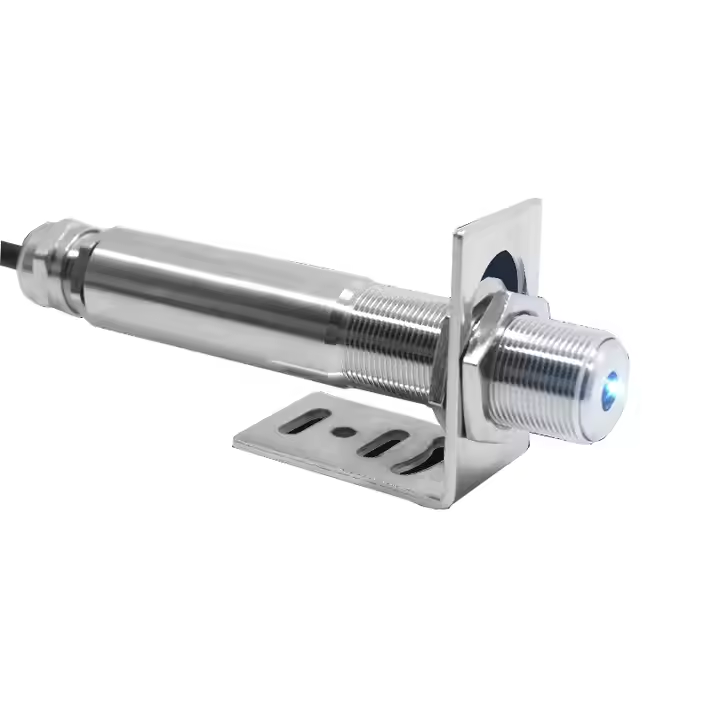Nell'industria moderna, in ambito medicale e nell'elettronica di consumo, la misurazione accurata della temperatura è essenziale. Come tecnologia avanzata di misurazione della temperatura senza contatto, il sensore di temperatura IR (infrarossi) si sta rapidamente diffondendo e sta cambiando i metodi di monitoraggio della temperatura in molti settori, grazie alla sua risposta rapida, all'elevata precisione e alla sicurezza.
Con il continuo progresso tecnologico, anche la tecnologia di misurazione della temperatura è in continua innovazione. I tradizionali sensori di temperatura a contatto, come termocoppie e termistori, pur essendo ancora efficaci in molte applicazioni, presentano limitazioni in alcuni scenari, come l'impossibilità di misurare la temperatura di oggetti in movimento, oggetti caldi o oggetti difficili da raggiungere. I sensori di temperatura a infrarossi superano queste limitazioni e aprono possibilità completamente nuove per la misurazione della temperatura.
Il principio di funzionamento del sensore di temperatura IR
Un sensore di temperatura a infrarossi misura la temperatura di un oggetto rilevando la radiazione infrarossa che emette. Secondo la legge di Stefan-Boltzmann, qualsiasi oggetto la cui temperatura sia superiore allo zero assoluto emetterà radiazione infrarossa. Il sistema ottico all'interno del sensore di temperatura a infrarossi raccoglie questa radiazione infrarossa e la focalizza sul rilevatore. Il rilevatore converte la radiazione infrarossa in un segnale elettrico e, dopo l'elaborazione del segnale, fornisce la lettura finale della temperatura in uscita.
Vantaggio principale
1. Misurazione senza contatto:
I sensori di temperatura a infrarossi non richiedono il contatto diretto con l'oggetto da misurare, quindi possono misurare in sicurezza la temperatura di oggetti caldi, in movimento o difficili da raggiungere. Questo è particolarmente importante in settori come la produzione industriale, la diagnostica medica e la lavorazione alimentare.
2. Risposta rapida e alta precisione:
I sensori di temperatura a infrarossi rispondono rapidamente alle variazioni di temperatura e forniscono letture in tempo reale. La loro precisione di misurazione può solitamente raggiungere ±1 °C o superiore, soddisfacendo le esigenze della maggior parte delle applicazioni.
3. Ampio intervallo di misura:
Il sensore di temperatura IR può misurare un'ampia gamma di temperature, da -50°C a +3000°C, ed è adatto a diversi ambienti con temperature estreme.
4. Misurazione e imaging multi-punto:
Alcuni sensori di temperatura IR avanzati possono effettuare misurazioni multi-punto o generare immagini delle distribuzioni di temperatura, utili per l'analisi termografica e la gestione termica.
Scenario applicativo
I sensori di temperatura a infrarossi vengono utilizzati in un'ampia gamma di applicazioni, tra cui:
1. Produzione industriale:
Viene utilizzato per il monitoraggio della temperatura nei processi di lavorazione dei metalli, saldatura, fusione e trattamento termico per garantire la qualità del prodotto e la sicurezza della produzione.
2. Campo medico:
Per la misurazione della temperatura senza contatto, soprattutto durante l'epidemia, i sensori di temperatura a infrarossi sono ampiamente utilizzati in aeroporti, stazioni, scuole, uffici e altri luoghi per lo screening della temperatura e la rapida individuazione dei pazienti con febbre.
3. Lavorazione degli alimenti:
Viene utilizzato per il monitoraggio della temperatura nelle linee di produzione alimentare, per garantire che la temperatura degli alimenti durante la lavorazione, lo stoccaggio e il trasporto soddisfi gli standard sanitari.
4. Gestione degli edifici e dell'energia:
Analisi termografica degli edifici per identificare i punti di dispersione del calore, ottimizzare l'uso dell'energia e migliorare l'efficienza energetica degli edifici.
5. Elettronica di consumo:
Integrato negli smartphone e nei dispositivi per la domotica per il monitoraggio della temperatura ambiente e la gestione della temperatura del dispositivo, per migliorare l'esperienza dell'utente.
Prospettive future
Con il continuo progresso tecnologico, le prestazioni dei sensori di temperatura a infrarossi saranno ulteriormente migliorate e i costi gradualmente ridotti. In futuro, si prevede che saranno ampiamente utilizzati in più settori, come l'agricoltura intelligente, le auto senza conducente e i robot intelligenti. Allo stesso tempo, con lo sviluppo dell'Internet delle cose e della tecnologia dei big data, i sensori di temperatura a infrarossi saranno integrati con altri dispositivi intelligenti per ottenere un monitoraggio della temperatura e un'elaborazione dei dati più intelligenti e automatizzati.
Caso di studio:
Durante la pandemia di COVID-19, i sensori di temperatura a infrarossi sono diventati uno strumento importante per lo screening della temperatura corporea. Molti luoghi pubblici, come aeroporti, stazioni e scuole, hanno installato sensori di temperatura a infrarossi per una rapida rilevazione della temperatura, migliorando efficacemente l'efficienza dello screening e riducendo il rischio di infezioni crociate. Ad esempio, un aeroporto internazionale ha installato diversi sensori di temperatura a infrarossi durante l'epidemia, in grado di rilevare la temperatura di oltre 100 persone al minuto in media, migliorando notevolmente l'efficienza dello screening.
Conclusione:
L'avvento dei sensori di temperatura a infrarossi segna l'ingresso della tecnologia di misurazione della temperatura in una nuova era. Non solo migliorano l'accuratezza e l'efficienza della misurazione della temperatura, ma forniscono anche un valido supporto per il monitoraggio della temperatura e la sicurezza in molti settori. Grazie alla loro ampia applicazione in vari campi, i sensori di temperatura a infrarossi apporteranno sicuramente maggiore praticità e sicurezza alla produzione e alla vita umana.
Per maggiori informazioni,
contattare Honde Technology Co., LTD.
Email: info@hondetech.com
Sito web aziendale:www.hondetechco.com
Data di pubblicazione: 15-01-2025


